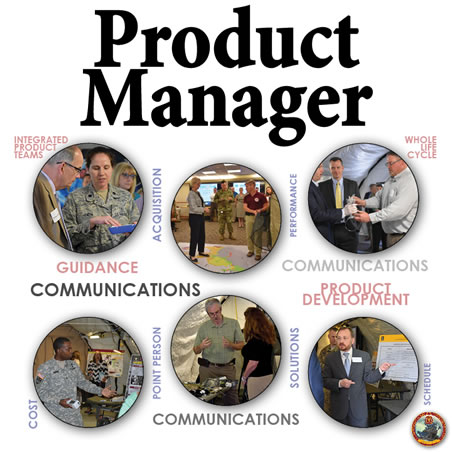Leadership and Communication Key Skills for Product Managers

Cost, schedule and performance are important considerations when developing medical solutions for the Warfighter. U.S. Army Medical Materiel Development Activity product managers oversee the process for making sure these elements are defined and kept on track as they guide the advanced development of medical products through the acquisition process.
"Product managers are big communicators," said Maj. Kara Schmid, product manager in the Neurotrauma and Psychological Health Project Management Office. "You should know at all times how much money you need, where you are in development, who you’re working with, what your issues are and what you need to fix the problems. We track this by communicating where we are and where we are going. We make sure everyone stays informed."
The product manager is the point person for everyone inside and outside of the organization. They serve as the main contact for anyone who has input into the development of their product. This may include industry, academia, USAMMDA co-workers and members of the Integrated Product Team.
The IPT, which is a construct of the Defense Acquisition System, determines the main framework of the plan to take the product through the full life cycle of development – from idea to final delivery. It is a core team element for developing and delivering any product anywhere in the Department of Defense. Each of the 10-15 members is a subject matter expert in a different topic area (e.g. medicine, science, finance, regulatory, etc.) relevant to the product.
All members need a nuanced understanding of the product to know what steps need to be taken to achieve defined success. To aid them with being better leaders, product managers usually have a background relevant to the products they direct. They may be scientists or engineers or they may have a business background. However, any past experience can be valuable to being a leader.
"I understand what a Warfighter needs, because I was that Warfighter," said Capt. Leonard Skipper, former product manager in the NPH PMO. "So it gives me an appreciation of pushing these products on to the Warfighter for better use." In the beginning of the process, the product manager will serve as co-chair with someone from the Science and Technology side, but as the project matures, the product manager will take over as chair. The product manager is a team member from the beginning and knows all the processes and relationships through to commercial marketing of the product.
"Solid leadership skills are a must as you need to corral different personalities in order to lead a team of very diverse individuals," said Schmid. “You need to make sure they stay on focus and that everyone is moving in the same direction. Everyone is an expert in a certain area and that is what they care about, so sometimes it’s hard to get everyone to see the value in everyone else’s areas.”
The IPT lays out all work that needs to be done, including figuring out how much development will cost and how long it will take. This is put into a baseline estimate and is updated as necessary. According to Schmid, one needs to be realistic, not optimistic when it comes to predictions. It is the product manager’s responsibility to report breaches in cost and schedule. It is better to identify issues as early as possible so risk mitigation strategies can be implemented.
"An essential part of planning acquisition is being able to look at the whole life cycle," said Dr. Cliff Snyder, product manager in the Pharmaceutical Systems PMO. "Even when a product is early on in the development stages, we are looking towards the completion of development, production, deployment and then sustainment."According to Snyder, just because a solution has been fielded, does not mean that the product manager’s work is complete. Unforeseen changes may arise. The manufacturer of the solution may go out of business or decide not to make the product any more as it may no longer be profitable for them. New technology may come along and require a change to the current product or make it altogether obsolete. It is the product manager’s responsibility to oversee these possibilities.
As the product develops, the IPT makes recommendations to senior decision makers. For example, the product manager gives an annual update (at a minimum) to the Milestone Decision Authority, who will provide guidance as to whether to continue, stop or change direction. Then, the product manager will take this feedback to the IPT.
Product managers make sure all assignments are completed as defined by the IPT. They work with whomever was tasked with getting the job done. This means being proactive in communicating with all of the people involved. Both Schmid and Skipper admit that means most of their days are spent in meetings, which is an efficient way of keeping everyone informed of the latest developments.
"When we put this uniform on and come to work, it’s all about the Warfighter. Getting these products out to the Warfighter," said Skipper. "All these meetings might seem tedious, but you just need to understand the bigger picture. You need to put it into proper perspective that years down the road your contributions now will tremendously help that Warfighter on the battlefield."
It is that commitment and belief in what they do that makes a good product manager. The products that USAMMDA is developing are in good hands.













